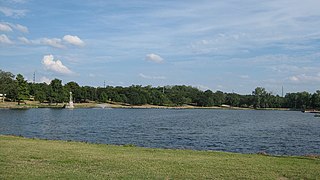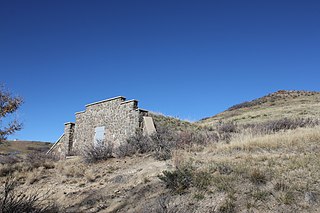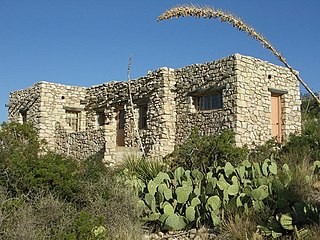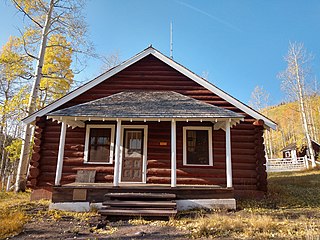
Red Rocks Park is a mountain park in Jefferson County, Colorado, owned and maintained by the city of Denver as part of the Denver Mountain Parks system. The park is known for its very large red sandstone outcrops. Many of these rock formations within the park have names, from the mushroom-shaped Seat of Pluto to the inclined Cave of the Seven Ladders. The most visited rocks, around Red Rocks Amphitheatre, are Creation Rock to the north, Ship Rock to the south, and Stage Rock to the east.

Camp Mabry is a military installation in Austin, Texas, housing the headquarters of the Texas Military Department, Texas Military Forces, and Texas Military Forces Museum. Established in 1892, Camp Mabry is the third-oldest active military installation in Texas, behind Fort Sam Houston and Fort Bliss. It was named for Brigadier General Woodford H. Mabry, the Adjutant General of Texas when the camp was founded. The camp was added to the National Register of Historic Places in 1996.

The Wintersmith Park Historic District, known locally as simply Wintersmith Park, is a historic district located at 18th Street and Scenic Drive in Ada, Oklahoma. The park includes a lake, a lodge, bridges, trails, courts and a public amphitheater. The area is listed in the National Register of Historic Places. The park is named for Frances Wintersmith.

The Central City/Black Hawk Historic District is a National Historic Landmark District that encompasses the developed areas of Central City and Black Hawk, Colorado, United States. They are adjacent former gold mining camps in the Front Range of the Rocky Mountains in Gilpin County, Colorado. For a time, the area was known as the Richest Square Mile on Earth, and was the largest urban area of the Colorado Territory in the 1870s.

The Georgetown–Silver Plume National Historic Landmark District is a federally designated United States National Historic Landmark that comprises the Town of Georgetown, the Town of Silver Plume, and the Georgetown Loop Historic Mining & Railroad Park between the two silver mining towns along Clear Creek in the Front Range of the Rocky Mountains in Clear Creek County, Colorado, United States.

Beaver Meadows Visitor Center, also known as Rocky Mountain National Park Administration Building, is the park headquarters and principal visitors center of Rocky Mountain National Park in central northern Colorado. Completed in 1967, it was designed by Taliesin Associated Architects, and was one of the most significant commissions for that firm in the years immediately following the death of founder Frank Lloyd Wright. It was also one of the last major projects completed under the Park Service Mission 66 project. It was declared a National Historic Landmark in 2001.

Camp George West Historic District or Camp George West was a military base for the Colorado National Guard, located at 15000 S. Golden Rd., Golden, Colorado. It was used as a rifle range, while artillery practice took place on Green Mountain, on the north side of present-day Hayden Park near Lakewood, Colorado. The Department of Defense Military Munitions Response Program has financed investigations to identify unexploded ordnance there since 2012.

Ammunition Igloo was a bunker used for arms storage at Camp George West, Golden, Colorado. It was built in 1940 of stone, supported by a soil-covered concrete arch. Rubble masonry, built of basalt, was used for the parapet-equipped facade.

The Saddlehorn Comfort Station is one of a group of related structures listed on the National Register of Historic Places in Colorado National Monument. The comfort station and the nearby caretaker's house, garage and the Saddlehorn Utility Area Historic District feature a consistent interpretation of the National Park Service Rustic style, featuring coursed ashlar sandstone masonry and log-supported roof structure. The comfort station was designed in 1936 by W.G. Carney of the National Park Service Branch of Plans and Designs, and built by labor from the Works Progress Administration and the Civilian Conservation Corps. Plans specified not only the general layout of the house and garage, but the specific dimensions of each stone and its location, using a technique of "built by detail".

The Moraine Park Museum and Amphitheater, also known as the Moraine Park Lodge and the Moraine Park Visitor Center, are located in Moraine Park, a glaciated meadow between two moraines in Rocky Mountain National Park.

The historical buildings and structures of Zion National Park represent a variety of buildings, interpretive structures, signs and infrastructure associated with the National Park Service's operations in Zion National Park, Utah. Structures vary in size and scale from the Zion Lodge to road culverts and curbs, nearly all of which were designed using native materials and regional construction techniques in an adapted version of the National Park Service Rustic style. A number of the larger structures were designed by Gilbert Stanley Underwood, while many of the smaller structures were designed or coordinated with the National Park Service Branch of Plans and Designs. The bulk of the historic structures date to the 1920s and 1930s. Most of the structures of the 1930s were built using Civilian Conservation Corps labor.

The Caverns Historic District comprises the central developed area of Carlsbad Caverns National Park. The complex was built between the early 1920s and 1942, initially in Pueblo Revival style, and later in New Mexico Territorial Revival style in the area around the natural entrance to Carlsbad Caverns. The earlier structures are built of local limestone, the later buildings in adobe. Thirteen buildings in the district are considered contributing structures. Buildings built between 1940 and 1942 were constructed with labor provided by the Civilian Conservation Corps.

The Recreation Center For the Utah State Hospital is a historic amphitheater in eastern Provo, Utah, United States, that is listed on the National Register of Historic Places.

The Grand Canyon Inn and Campground, also known as the North Rim Inn, were built by the William W. Wylie and the Utah Parks Company as inexpensive tourist accommodations on the North Rim of the Grand Canyon, in Grand Canyon National Park. Intended to complement the more expensive Grand Canyon Lodge, the cabins and Inn were located near Bright Angel Point, but father back than their more expensive counterparts, near the Grand Canyon North Rim Headquarters. The design of the cabins and the redesign of the Inn building were undertaken by architect Gilbert Stanley Underwood.
Architects of the National Park Service are the architects and landscape architects who were employed by the National Park Service (NPS) starting in 1918 to design buildings, structures, roads, trails and other features in the United States National Parks. Many of their works are listed on the National Register of Historic Places, and a number have also been designated as National Historic Landmarks.

Shady Lake Recreation Area is a campground and public recreation area in southwestern Ouachita National Forest, southwest of Mena, Arkansas and west of Glenwood, Arkansas. The area is oriented around Shady Lake, a body of water on the South Fork Saline River impounded by a dam built c. 1940 by the Civilian Conservation Corps (CCC). The area is administered by the United States Forest Service (USFS).

The Camp Dodge Pool District, also known as the Camp Dodge Swimming Pool Complex, is a nationally recognized historic district located in Johnston, Iowa, United States. It was listed on the National Register of Historic Places in 1995. At the time of its nomination it consisted of three resources, which included two contributing buildings and one contributing structure. It consisted of a 2,300,000-US-gallon (8,700,000 L) swimming pool, a bathing pavilion, and a concession stand. The complex was built at Camp Dodge, the headquarters of the Iowa National Guard. When it was completed in 1922, the pool could accommodate between 1,000 and 2,000 people and it may have been the largest in the country. The following year, however, a larger pool was built in San Francisco.

The Pyramid Guard Station, in Rio Blanco County, Colorado near Yampa, Colorado, was built in 1934. It is located off County Route 8 in Routt National Forest, between Dunckley Pass and Ripple Pass. It is just west of the East Fork Williams Fork in an aspen forest.

The Arrowhead Lodge, at 34500 Poudre Canyon Hwy., Roosevelt National Forest, in Larimer County, Colorado, served by the post office in unincorporated Bellvue, Colorado, was a resort camp which was built in 1931. It was listed on the National Register of Historic Places in 1992.




















